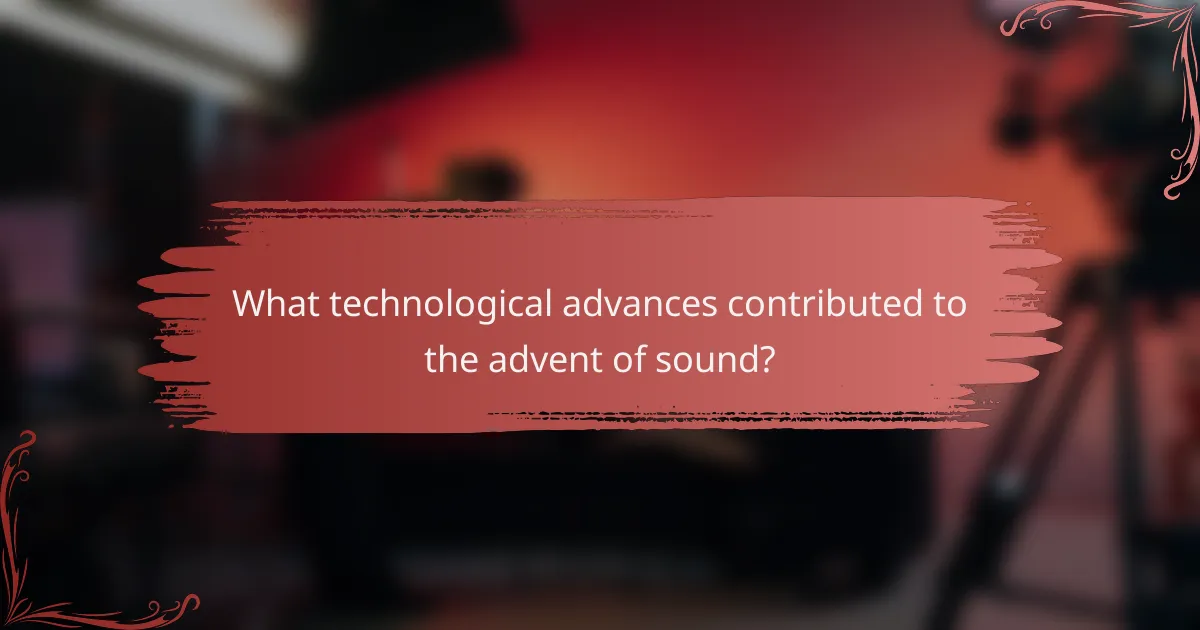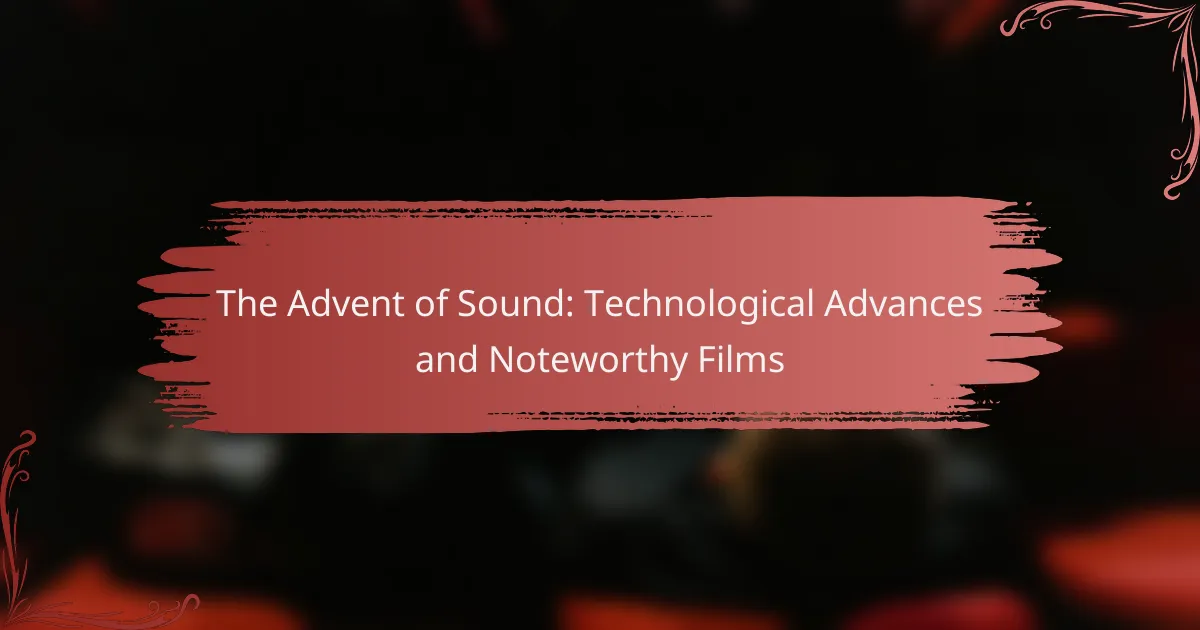The advent of sound in film refers to the introduction of synchronized soundtracks that allowed dialogue and sound effects to accompany moving images, fundamentally transforming the film industry beginning in the late 1920s. Notable films such as “The Jazz Singer,” released in 1927, exemplified this shift by featuring synchronized dialogue and musical numbers, marking a significant milestone in cinema history. Technological advancements, including the phonograph and the Vitaphone system, facilitated the transition from silent films to “talkies,” altering audience experiences and filmmaking techniques. This article explores the technological developments that enabled sound in cinema and highlights key films that defined this pivotal era in filmmaking.

What is the Advent of Sound in Film?
The advent of sound in film refers to the introduction of synchronized soundtracks, enabling dialogue and sound effects to accompany moving images. This technological advancement began in the late 1920s, transforming the film industry. The first successful sound film, “The Jazz Singer,” was released in 1927. It featured synchronized dialogue and musical numbers, marking a pivotal moment in cinema history. Prior to this, films were silent, relying on visual storytelling and live musical accompaniment. The transition to sound films significantly changed audience experiences and filmmaking techniques. By 1930, most major studios had adopted sound technology, leading to the decline of silent films. This shift also influenced genres and storytelling methods, as filmmakers began to explore the potential of sound in enhancing narratives.
How did sound technology evolve in the film industry?
Sound technology in the film industry evolved through several key advancements. Initially, silent films dominated the early 20th century. The introduction of synchronized sound in the late 1920s marked a significant turning point. “The Jazz Singer,” released in 1927, was the first feature film to include synchronized dialogue. This innovation led to the widespread adoption of sound in films.
By the 1930s, sound technology improved with the development of multi-track recording. This allowed for clearer audio and the layering of sound effects and music. The introduction of Dolby sound in the 1970s further enhanced audio quality. Surround sound systems became standard in theaters, providing an immersive experience.
Today, digital sound technology continues to advance. Innovations like immersive audio formats, such as Dolby Atmos, create a three-dimensional sound environment. These developments have transformed the way audiences experience films.
What were the key milestones in the development of sound in cinema?
The key milestones in the development of sound in cinema include the introduction of synchronized sound in the late 1920s. The first successful sound film was “The Jazz Singer,” released in 1927. This film featured synchronized dialogue and music, revolutionizing the industry. Prior to this, silent films relied on live music and title cards. The Vitaphone system was crucial for synchronizing sound with film. In 1930, “Lights of New York” became the first all-talking feature film. By the mid-1930s, sound technology had become standard in filmmaking. The transition to sound significantly changed storytelling techniques and audience engagement.
How did early filmmakers adapt to the introduction of sound?
Early filmmakers adapted to the introduction of sound by integrating synchronized audio into their films. They utilized technologies such as the Vitaphone system, which paired sound with film. Filmmakers learned to adjust their storytelling techniques to incorporate dialogue and sound effects. This transition required new skills in sound recording and mixing. Many silent film stars struggled with the new demands of speaking roles. The industry saw a shift in genres, with musicals gaining popularity. Filmmakers also faced technical challenges, like microphone placement and acoustics. Overall, the adaptation to sound transformed the filmmaking process and audience experience.
Why is the advent of sound significant in film history?
The advent of sound is significant in film history because it transformed storytelling and audience engagement. Prior to sound, films relied solely on visual elements and intertitles. The introduction of synchronized sound in the late 1920s allowed for dialogue, music, and sound effects. This innovation enhanced emotional depth and realism in films. A landmark film, “The Jazz Singer” (1927), is recognized as the first significant “talkie.” It showcased the potential of sound in cinema, leading to widespread adoption. By 1930, nearly all major studios had transitioned to sound films. This shift profoundly impacted film production, acting styles, and audience expectations. Sound made films more accessible and engaging, solidifying cinema as a dominant entertainment medium.
What impact did sound have on storytelling in films?
Sound significantly enhanced storytelling in films by adding emotional depth and context. It allowed filmmakers to convey character emotions through dialogue and music. This innovation began with “The Jazz Singer” in 1927, which integrated synchronized sound. Audiences experienced a more immersive narrative with sound effects and ambient noise. Sound also enabled the use of silence for dramatic effect, creating tension. The combination of visuals and sound led to a richer storytelling experience. Overall, sound transformed films into a more engaging and expressive medium.
How did sound change audience experiences in theaters?
Sound transformed audience experiences in theaters by enhancing emotional engagement and storytelling. The introduction of synchronized sound in films, starting with “The Jazz Singer” in 1927, allowed audiences to hear dialogue, music, and sound effects. This innovation made narratives more immersive and relatable. Audiences could connect with characters through their voices and emotional expressions. The use of sound also heightened dramatic tension and comedic timing. Research indicates that films with sound improved viewer retention and enjoyment. The combination of visuals and audio created a richer cinematic experience, fundamentally changing how stories were told and received.

What technological advances contributed to the advent of sound?
The advent of sound in film was significantly influenced by several technological advances. The introduction of the phonograph in 1877 allowed for sound recording and playback. This innovation paved the way for synchronized sound in cinema. The Vitaphone system, developed in the 1920s, enabled sound to be recorded on discs synchronized with film. The release of “The Jazz Singer” in 1927 marked a pivotal moment, showcasing synchronized dialogue and music. Additionally, advancements in sound recording techniques improved audio quality in films. The transition from silent films to “talkies” transformed the film industry. These technological developments laid the foundation for modern sound in cinema.
What were the major innovations in sound recording and playback?
Major innovations in sound recording and playback include the phonograph, magnetic tape, and digital audio. The phonograph, invented by Thomas Edison in 1877, was the first device to record and reproduce sound. Magnetic tape, developed in the 1930s, allowed for better sound quality and editing capabilities. The introduction of compact discs in the 1980s revolutionized playback with digital sound. Digital audio workstations emerged in the 1990s, enabling complex sound manipulation. Each innovation significantly improved the fidelity and accessibility of recorded sound. These advancements laid the foundation for modern audio technology.
How did the transition from silent films to talkies occur?
The transition from silent films to talkies occurred with the introduction of synchronized sound technology. This change began in the late 1920s. The first successful sound film, “The Jazz Singer,” was released in 1927. It featured synchronized dialogue and musical numbers. The success of “The Jazz Singer” demonstrated the commercial potential of sound in cinema. Following this, studios invested in sound technology. By 1929, most major studios began producing sound films. The transition was marked by both technical advancements and audience demand for more immersive experiences.
What role did sound mixing and editing play in film production?
Sound mixing and editing are crucial in film production. They enhance the overall audio experience and support storytelling. Sound mixing balances dialogue, music, and sound effects. This process ensures clarity and emotional impact. Editing refines audio tracks to align with visuals. It helps create a cohesive narrative flow. Historical examples show that effective sound mixing elevates films. Notable films like “Star Wars” utilized innovative sound design techniques. These advancements have shaped modern cinematic experiences significantly.
How did advancements in sound technology influence film genres?
Advancements in sound technology significantly influenced film genres by enhancing storytelling and audience engagement. The transition from silent films to “talkies” in the late 1920s marked a pivotal change. This transition allowed dialogue to convey character emotions and plot details more effectively. Genres such as musicals emerged, capitalizing on synchronized sound to showcase musical performances. Additionally, horror films utilized sound effects to create suspense and evoke fear, as seen in “Psycho” (1960). Comedies also benefited, with verbal humor becoming a central element due to the ability to deliver jokes through dialogue. Overall, sound technology expanded creative possibilities, allowing filmmakers to explore new narrative techniques and genre conventions.
What genres were most affected by the introduction of sound?
Musicals and comedies were the genres most affected by the introduction of sound. The incorporation of synchronized sound allowed for the enhancement of musical numbers and dialogue. Musicals flourished as they could showcase singing and orchestration. Comedies benefited from the addition of spoken jokes and sound effects. Dramas also saw significant changes, as emotional performances became more impactful with voice. The transition to sound fundamentally altered storytelling techniques across these genres. Historical context shows that “The Jazz Singer” (1927) marked a pivotal moment in this transition. This film’s success demonstrated the commercial viability of sound in cinema.
How did sound design evolve alongside technological advancements?
Sound design evolved significantly with technological advancements. Early sound design relied on live sound effects and simple recording techniques. The introduction of synchronized sound in the late 1920s transformed filmmaking. Innovations like the Vitaphone system allowed for recorded music and dialogue. The 1950s brought magnetic tape, enhancing sound quality and editing capabilities. Digital technology emerged in the 1980s, enabling precise sound manipulation. The advent of software like Pro Tools revolutionized audio editing and mixing. Today, immersive sound design uses technologies like Dolby Atmos for spatial audio experiences. These advancements have continually shaped the way sound is integrated into film, enhancing storytelling and audience engagement.

What are some noteworthy films that exemplify the advent of sound?
The noteworthy films that exemplify the advent of sound include “The Jazz Singer,” “Don Juan,” and “Wings.” “The Jazz Singer,” released in 1927, is often credited as the first significant “talkie.” It featured synchronized dialogue and songs, revolutionizing the film industry. “Don Juan,” released in 1926, was one of the first films to use the Vitaphone system, incorporating a synchronized musical score and sound effects. “Wings,” released in 1927, was the first film to win an Academy Award for Best Picture and featured synchronized sound effects and dialogue. These films mark key milestones in the transition from silent films to sound films, showcasing the technological advancements of the era.
Which films marked significant achievements in sound technology?
“Steamboat Willie” marked a significant achievement in sound technology as it was one of the first synchronized sound cartoons. Released in 1928, it featured synchronized dialogue and music, setting a new standard for animated films. “The Jazz Singer,” released in 1927, was the first feature-length “talkie,” incorporating synchronized dialogue and songs. This film revolutionized the industry by demonstrating the potential of sound in storytelling. “Apocalypse Now,” released in 1979, showcased advanced sound design techniques and multi-channel audio. It won an Academy Award for Best Sound, highlighting its impact on sound technology in film. “Star Wars,” released in 1977, introduced innovative sound effects and the use of Dolby stereo, enhancing the cinematic experience. These films collectively represent milestones in the evolution of sound technology in cinema.
What innovations were introduced in classic films like “The Jazz Singer”?
“The Jazz Singer” introduced synchronized sound to film, marking a significant innovation in cinema. This 1927 film was the first feature-length movie to include synchronized dialogue and singing. The use of the Vitaphone sound-on-disc system allowed for audio to be played in sync with the film. This technological advancement transformed the movie-going experience. Audiences were captivated by the integration of music and spoken words. “The Jazz Singer” set a precedent for future films, leading to the widespread adoption of sound in cinema. This shift fundamentally changed storytelling techniques in the film industry. The success of “The Jazz Singer” paved the way for the “talkie” era in Hollywood.
How did films in different eras utilize sound creatively?
Films in different eras utilized sound creatively through innovative techniques and technologies. In the silent film era, filmmakers used title cards and live music to convey emotion. The introduction of synchronized sound in the late 1920s transformed storytelling. “The Jazz Singer,” released in 1927, was the first major “talkie,” combining dialogue with music. In the 1930s, sound effects enhanced realism, as seen in “King Kong.” The 1950s saw the rise of stereo sound, enriching the auditory experience in films like “Oklahoma!” By the 1970s, surround sound became prominent, exemplified in “Star Wars.” Each era’s advancements in sound technology pushed creative boundaries, shaping cinematic experiences.
What lessons can contemporary filmmakers learn from these films?
Contemporary filmmakers can learn the importance of sound design from early sound films. These films demonstrated how sound enhances storytelling and emotional depth. For instance, “The Jazz Singer” showcased synchronized dialogue, revolutionizing audience engagement. Filmmakers should prioritize sound quality to create immersive experiences. Additionally, the use of music in these films illustrated its power to evoke emotions. Understanding the relationship between sound and visuals is crucial for modern storytelling. The success of these early films proves that sound is not just an accessory but a vital component of filmmaking.
How can modern sound design enhance storytelling in today’s films?
Modern sound design enhances storytelling in today’s films by creating immersive auditory experiences. It utilizes advanced technology to shape the emotional tone of scenes. For instance, sound effects can amplify tension during critical moments. Dialogue clarity is improved through techniques like ADR (Automated Dialogue Replacement). Surround sound systems engage viewers, making them feel part of the narrative. The use of soundscapes establishes setting and mood effectively. According to a study by the University of Southern California, sound design significantly influences audience emotional responses. This demonstrates the crucial role sound plays in modern filmmaking.
What best practices can filmmakers adopt from historical sound techniques?
Filmmakers can adopt several best practices from historical sound techniques. First, they should prioritize sound design as a narrative tool. Historical films often used sound to enhance storytelling, creating emotional depth. Second, filmmakers can learn the importance of location sound recording. Early sound films emphasized capturing authentic ambient sounds to create realism. Third, employing Foley techniques can add layers to soundscapes. This practice originated in the early days of cinema to recreate sound effects that were not captured during filming. Fourth, filmmakers should consider the use of sound bridges. This technique, used in classic films, helps to smooth transitions between scenes. Lastly, understanding the balance between dialogue and sound effects is crucial. Historical techniques often highlighted the clarity of dialogue while integrating sound effects seamlessly. These practices can enhance modern filmmaking by enriching the auditory experience for audiences.
The advent of sound in film marks a significant technological advancement that transformed the cinematic experience, beginning in the late 1920s with the release of “The Jazz Singer” in 1927. This article explores the evolution of sound technology, key milestones in its development, and the impact on filmmaking and audience engagement. It highlights how early filmmakers adapted to sound, the innovations in sound recording and playback, and the influence of sound on various film genres. Additionally, it examines noteworthy films that exemplify these advancements and the lessons contemporary filmmakers can learn from historical sound techniques.
